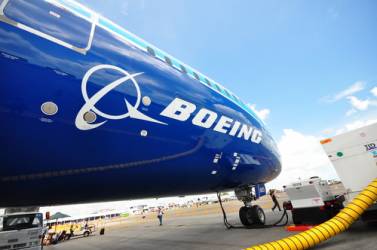Boeing has released its Q2 2025 results, revealing significant operational improvement despite persistent profitability challenges. Revenue surged by 35% year-on-year to $22.75 billion, surpassing analyst expectations of $21.68 billion. This was primarily driven by increased commercial aircraft deliveries. The company also appears to be overcoming negative public relations associated with the 737 MAX issues.
Key Financial Indicators:
-
Core loss per share: -$1.24 (better than expected -$1.40)
-
GAAP loss per share: -$0.92
-
Operating cash flow: $227 million (versus -$3.9 billion in Q2 2024)
-
Free cash flow: -$200 million (versus -$4.3 billion a year earlier)
-
Commercial aircraft deliveries: 150 units (+63% year-on-year)
Segmental Analysis
Commercial Airplanes - The Primary Growth Engine
The Commercial Airplanes segment generated revenue of $10.87 billion, an 81% year-on-year increase, accounting for 47.8% of the company's total revenue. 737 production met its target of 38 aircraft per month, with plans to increase to 42 later this year. 787 Dreamliner production rose to 7 aircraft per month. Despite the revenue growth, the segment continues to incur operating losses of $557 million, albeit an improvement from losses of $715 million a year prior.
Defense, Space & Security - Return to Profitability
The Defense segment achieved revenue of $6.62 billion (+10% year-on-year) and an operating profit of $110 million, a significant turnaround from losses of $913 million in Q2 2024. The segment's operating margin stood at 1.7%, indicating a stabilization of operational performance after several challenging quarters.
Global Services - Highest Profitability
Global Services generated revenue of $5.28 billion (+8% year-on-year) with the highest operating margin among all segments at 19.9%. The segment has consistently improved profitability, with its margin increasing from 2.9% in 2020 to 18.13% in 2024.
Financial Position and Liquidity
Boeing concluded the quarter with $23 billion in cash and short-term investments (down from $23.7 billion at the beginning of the quarter) and $53.3 billion in total debt (down from $53.6 billion). The company has access to $10 billion in undrawn credit lines.
The order backlog increased to a record $619 billion, including over 5,900 commercial aircraft valued at $522 billion. In Q2 2025, Boeing secured 455 new aircraft orders, including significant commitments from Qatar Airways and British Airways.
Positive and Negative Aspects of the Results
Positives:
-
The company recorded a marked 63% year-on-year increase in commercial aircraft deliveries, the best result since 2018.
-
Operating cash flow significantly improved compared to the previous year, reaching $227 million in Q2 2025 versus -$3.9 billion last year.
-
Production of the flagship 737 model reached 38 aircraft per month, with plans to exceed 40.
-
Return to profitability in the defense segment and the highest profitability in services.
-
A high backlog indicates stable financial performance for the coming years.
Challenges and Risks:
-
The company continues to generate losses, primarily in its key commercial aircraft segment.
-
Boeing maintains high debt exceeding $50 billion, although it is not utilizing available credit lines.
-
Negative free cash flow, despite a significant reduction in scale compared to last year.
Management Commentary and Outlook
CEO Kelly Ortberg emphasized a focus on "restoring confidence and continuing progress in the recovery process." The key will be to maintain the pace of delivery growth while improving quality control and safety. Plans include increasing 737 production to 42 per month.
The company shows clear improvement over the previous year, as evidenced by a distinct revenue increase driven by higher deliveries. Simultaneously, a return to overall company profitability remains a challenge.
The company's shares are up approximately 1.2% in pre-market trading. Year-to-date, however, the stock has risen by 33%. Strong gains have occurred primarily since April, when shares climbed from a low of $140 to $240 per share.
TSMC Earnings Preview: Will the Key Semiconductor Supplier Surprise the Market?
US Open: American Indices Rally on Anticipated End of Fed Balance Sheet Reduction
Bank of America, Wells Fargo, and Morgan Stanley: Q3 2025 Earnings Overview
Abbott reports no surprises in Q3, but tariff risks and lowered forecasts drag the share price down💡
The material on this page does not constitute as financial advice and does not take into account your level of understanding, investment objectives, financial situation or any other particular needs.
All the information provided, including opinions, market research, mathematical results and technical analyses published on the website or transmitted to you by other means is provided for information purposes only and should in no event be interpreted as an offer of, or solicitation for, a transaction in any financial instrument, nor should the information provided be construed as advice of legal or fiscal nature.
Any investment decisions you make shall be based exclusively on your level of understanding, investment objectives, financial situation or any other particular needs. Any decision to act on information published on the website or transmitted to you by other means is entirely at your own risk. You are solely responsible for such decisions.
If you are in doubt or are not sure that you understand a particular product, instrument, service, or transaction, you should seek professional or legal advice before trading.
Investing in OTC Derivatives carries a high degree of risk, as they are leveraged based products and often small movements in the market could lead to much larger movements in the value of your investment and this could work against you or for you. Please ensure that you fully understand the risks involved, taking into account your investments objectives and level of experience, before trading, and if necessary, seek independent advice.


